In recent years, sustainable construction has gained significant traction as a response to the growing awareness of the environmental impact of traditional building methods. This long-form article delves into the benefits of sustainable construction and highlights eco-friendly and energy-efficient products that are transforming the industry. By understanding the advantages of these innovative building practices and materials, you will be better equipped to make informed decisions for your construction projects and contribute to a greener future.
Sustainable Construction: What Is It & Why Does It Matter?
Sustainable construction refers to the use of eco-friendly materials, energy-efficient techniques, and green building practices that reduce the negative environmental impact of construction projects. This approach is crucial for addressing climate change, preserving natural resources, and promoting healthier living environments. In the following sections, we'll explore the benefits of adopting sustainable construction practices and discuss the eco-friendly products that make a difference.
Sustainable Construction Techniques
Various techniques and strategies are employed in sustainable construction to minimize its environmental impact. Some examples include:
Passive solar design: Incorporating building features that maximize natural light and heat, reducing the need for artificial lighting and heating systems.
Rainwater harvesting: Collecting and storing rainwater for non-potable uses, such as irrigation or toilet flushing, to conserve water resources.
Waste reduction: Implementing construction waste management plans to minimize waste generation and promote recycling or reuse of materials.
Green roofs and living walls: Integrating vegetation into building exteriors to improve insulation, absorb rainwater, and provide habitat for local wildlife.
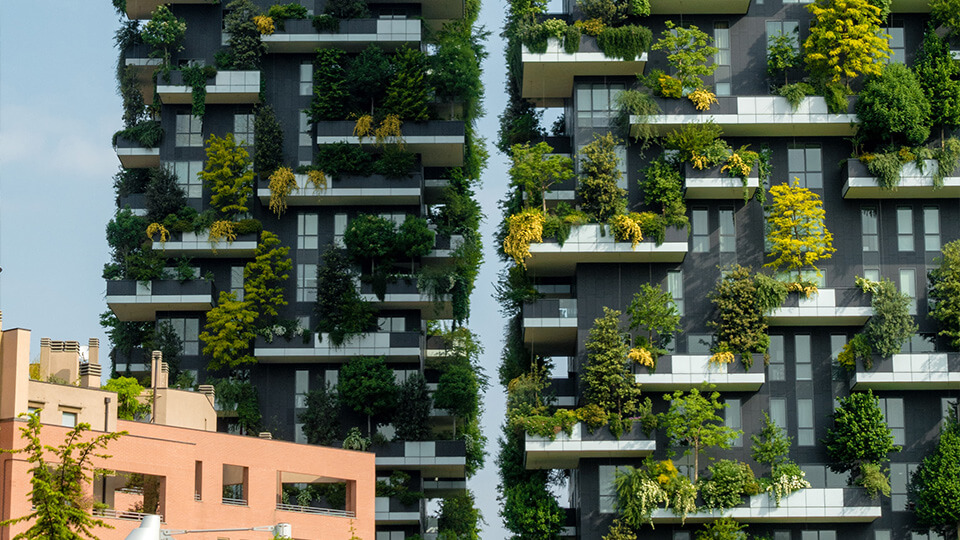
Various plants cover the exterior of buildings, improving air quality, and reducing heat absorption. Photo by Daniel Sebler
Sustainable Construction Principles
Sustainable construction is guided by several key principles that help minimize its environmental impact. These principles include:
Resource efficiency: Optimizing the use of resources such as water, energy, and materials to reduce waste and pollution.
Site selection and design: Choosing sites with minimal ecological disruption and designing buildings that complement the local ecosystem and climate.
Lifecycle thinking: Considering the long-term impacts of construction projects, from material extraction and manufacturing to building operation, maintenance, and eventual deconstruction.
Adaptability and resilience: Designing buildings that can easily adapt to changing needs and withstand environmental challenges, such as extreme weather events or shifting climate conditions.
Energy Efficiency and Cost Savings
One of the primary benefits of sustainable construction is its focus on energy efficiency. By optimizing insulation, utilizing energy-efficient windows, and implementing smart technologies, green buildings can significantly reduce energy consumption. This not only lowers greenhouse gas emissions but also translates into substantial cost savings on utility bills for homeowners and businesses.
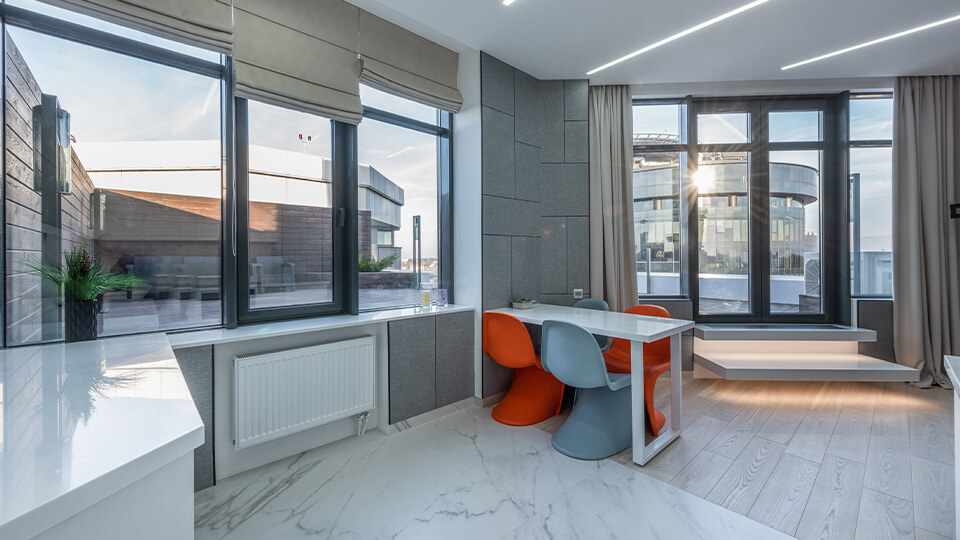
An apartment with large windows and skylights that maximize natural light and heat, benefiting people's lives. Photo by Max Rahubovskiy
Energy-Efficient Windows
Energy-efficient windows play a significant role in minimizing heat transfer and reducing energy consumption in sustainable buildings. Some features of energy-efficient windows include
Double or triple glazing: Multi-pane windows with gas-filled spaces between the panes offer improved insulation, reducing heat loss in winter and heat gain in summer.
Low-emissivity (low-E) coatings: These thin, metallic coatings on window glass helps reflect heat while allowing light to pass through, enhancing energy efficiency.
High-quality window frames: Frames made of materials like wood, fiberglass, or vinyl offer better insulation compared to traditional aluminum frames.
Smart Technologies
Incorporating smart technologies in sustainable buildings can further enhance energy efficiency and result in cost savings. Some examples of smart technologies include
Smart thermostats: These devices allow occupants to program and control their heating and cooling systems remotely, optimizing energy use and reducing utility costs.
Energy-efficient lighting: LED lights and automated lighting controls can significantly reduce energy consumption by adjusting light levels based on occupancy and natural light availability.
Energy management systems: These systems monitor and optimize energy use throughout a building, identifying areas for improvement and adjusting systems accordingly to minimize energy waste. For instance, The Crystal (London, UK): This striking building, designed by Siemens, features solar panels, a ground-source heat pump, and a highly efficient building envelope, resulting in a 70% reduction in energy consumption compared to traditional office buildings.
Improved Indoor Air Quality and Health
Sustainable construction emphasizes using non-toxic materials and improved ventilation systems, resulting in healthier indoor environments. This can reduce the risk of respiratory issues, allergies, and other health concerns associated with poor air quality, ultimately enhancing occupants' well-being and comfort.
Non-Toxic Building Materials
Sustainable construction prioritizes the use of non-toxic materials to minimize indoor air pollution. Some examples of non-toxic building materials include:
Low-VOC paints and finishes: Volatile Organic Compounds (VOCs) are harmful chemicals found in many traditional paints and finishes. Low-VOC alternatives emit fewer pollutants, improving indoor air quality.
Natural insulation materials: Sustainable insulation options, such as sheep's wool, cellulose, or cork, are healthier choices compared to traditional fiberglass insulation, which can release harmful particles into the air.
Formaldehyde-free cabinetry and furniture: Formaldehyde, a common component in adhesives used in cabinetry and furniture, can off-gas and contribute to poor indoor air quality. Sustainable construction favors formaldehyde-free alternatives to reduce exposure.
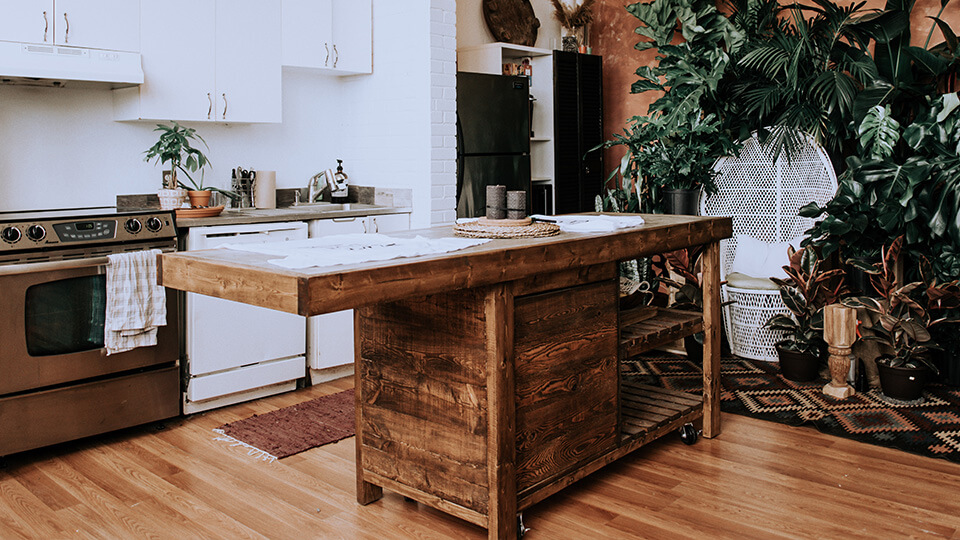
The island cabinets are made from reclaimed wood, giving new life to old materials and reducing waste. Photo by Eddy Lee
Improved Ventilation Systems
Enhanced ventilation systems play a crucial role in maintaining healthy indoor air quality in sustainable buildings. Some examples of these systems include:
Heat recovery ventilators (HRVs): HRVs exchange stale indoor air with fresh outdoor air while recovering heat from the outgoing air to minimize energy loss.
Energy recovery ventilators (ERVs): Similar to HRVs, ERVs also transfer humidity between incoming and outgoing air, helping to maintain optimal indoor humidity levels.
A demand-controlled ventilation (DCV): This smart ventilation system adjusts airflow based on the number of occupants or specific air quality parameters, ensuring optimal air quality without wasting energy.
Enhanced Durability and Longevity
Eco-friendly building materials, such as recycled steel, reclaimed wood, and rammed earth, are often more durable and require less maintenance than conventional options. This increased durability translates to longer-lasting structures, reducing the need for frequent repairs and replacements.
Durable Eco-Friendly Building Materials
Sustainable construction utilizes eco-friendly materials that offer increased durability and require less maintenance. Some examples include:
Recycled steel: Recycled steel is a durable and strong building material with high resistance to corrosion, pests, and fire, making it a long-lasting choice for structural elements.
Reclaimed wood: Reclaimed wood, sourced from old buildings or other structures, often has a unique character and can be more resistant to warping or rotting than freshly harvested lumber.
Rammed earth: This age-old construction technique involves compacting layers of soil to create sturdy walls that provide excellent thermal mass and can last for centuries with minimal maintenance.
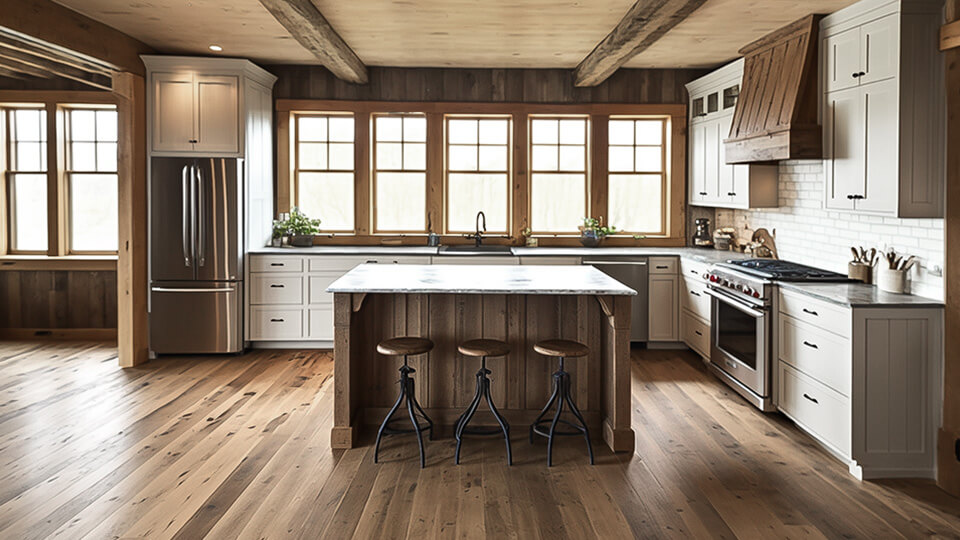
Using reclaimed wood planks for flooring, wall paneling, and ceiling treatments in a home renovation or new construction project.
Green Building Practices for Enhanced Longevity
Sustainable construction practices not only focus on using durable materials but also on building techniques that extend the lifespan of structures. Some of these practices include:
Design for adaptability: Creating flexible spaces that can easily be modified to accommodate changing needs or new technologies can prolong a building's life and reduce the need for extensive renovations.
Quality craftsmanship: Emphasizing high-quality workmanship in construction projects ensures that structures are built to last and require less maintenance over time.
Proper building envelope design: Constructing a well-designed building envelope that effectively manages moisture, air, and thermal transfer can prevent damage from water infiltration, mold, and energy loss, extending a building's lifespan.
Innovative Energy-efficient Technologies
In addition to eco-friendly materials, sustainable construction projects often incorporate advanced technologies to further enhance energy efficiency. Examples of such innovations include
Solar panels: Harnessing solar energy to generate electricity and reducing reliance on fossil fuels.
Geothermal systems: Utilizing the earth's stable temperatures for heating and cooling purposes, reducing energy consumption.
Smart home automation: Allowing homeowners to control and optimize their energy use through automated systems and devices.
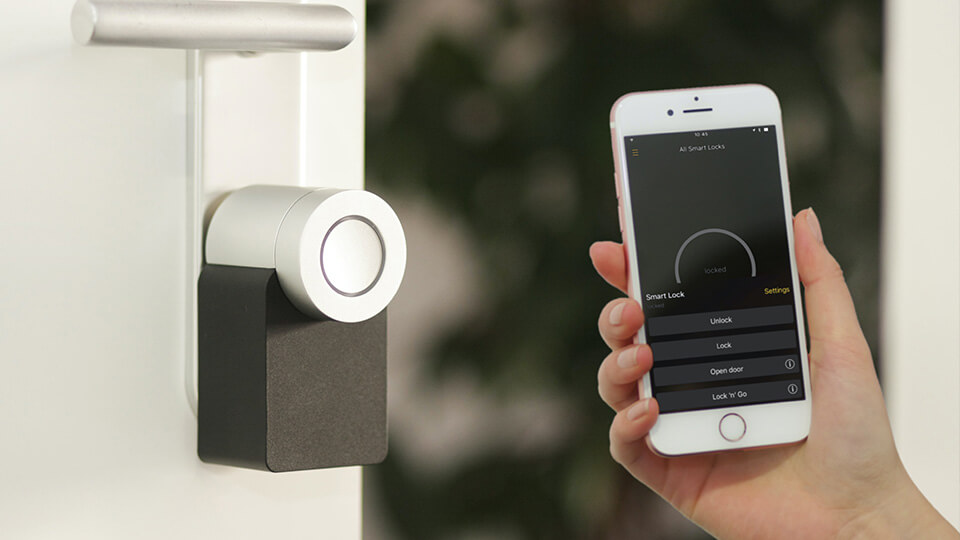
Smart security systems that allow remote monitoring and control of locks, cameras, and alarms. Photo by Sebastian Scholz (Nuki) on Unsplash
Choosing the Right Sustainable Construction Products
When selecting eco-friendly and energy-efficient products for your project, consider factors such as durability, local availability, recyclability, and energy efficiency. Research the manufacturing processes and environmental impacts of various materials to make an informed decision. Consulting with green building professionals and obtaining certifications, such as LEED or BREEAM, can also help ensure your project adheres to sustainable construction standards.
Consider the product's lifecycle and end-of-life options. Can it be recycled or repurposed after its use?
Choose products that are low in VOCs (volatile organic compounds) to improve indoor air quality.
Use energy-efficient lighting and appliances, such as LED lights and Energy Star-rated appliances.
Opt for products that require less maintenance or replacement, such as metal roofing or concrete pavers.
Consider the transportation and shipping impacts of products. Choosing locally sourced materials can reduce the carbon footprint of your project.
Sustainable construction offers numerous benefits, from energy efficiency and cost savings to improved indoor air quality and reduced environmental impact. By embracing eco-friendly and energy-efficient materials and technologies, homeowners, businesses, and developers can contribute to a greener, more sustainable future. As the demand for sustainable construction continues to grow, investing in eco-friendly building practices and products not only makes environmental sense but also offers long-term financial advantages. By understanding the benefits of sustainable construction and choosing the right products for your project, you can make a lasting, positive impact on both your property and the environment.
